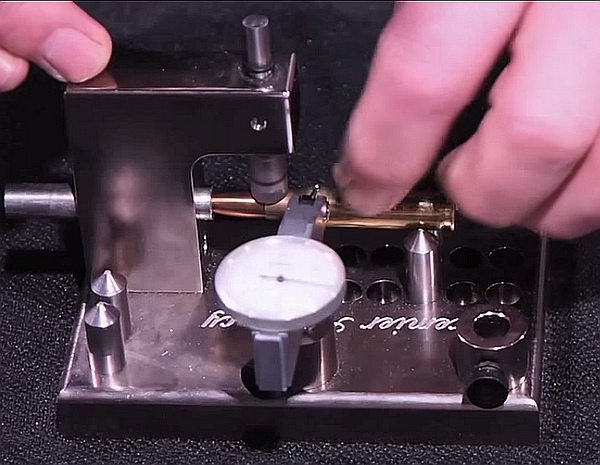Bill Goad Concentricity Gauge Works by Impact
Over the years, many different concentricity tools have been on the market. Various approaches have been taken to straightening rounds that exhibit poor concentricity. With extreme examples of excessive run-out, the bullet is is visibly crooked in the neck with the bullet tip clearly off-center. That’s never a good thing. Straight ammo shoots better.

Straighten-Up and Fly Right
If you could straighten up crooked rounds, accuracy should be improved. In the past, some tools promised more than they delivered. But now Bill Goad, a record-setting benchrest shooter, has invented a new tool that improves concentricity via an impact or “jarring” method. A vertical rod with a curved face mates with the case-neck. You spin the case to find the “high spot” of max eccentricity. Then just tap the rod a couple of times and the neck comes back onto centerline. You can then confirm the concentricity improvement with the dial indicator. Watch the video to see how this is done. Pay particular attention to times 01:25 to 01:45. The case starts at .004″ run-out (01:32). After correction (01:40) the neck shows less than .001″ (one-thousandth) run-out.
Benchrest ace Bill Goad demonstrates his innovative Fli-Right Concentricity gauge tool. It works differently than other concentricity enhancers on the market.
Bill Goad knows something about accuracy. He shot a 10-target 100/200 benchrest Combined Aggregate of 0.178″ (see video at 00:15-00:35). Bill Goad’s tool offers advantages over systems that clamp a cartridge at both ends and try to bend the case or tilt the bullet without straightening the neck. Goad’s new Fli-Right tool is available now from PremierAccuracy.com.

Similar Posts:
- H&H Concentricity Gauge and Bullet Straightener
- Videos Show Functions of Hornady Concentricity Gauge
- Joe Krupa Wins Big at IBS Group Nationals
- IBS 100/200 Nationals Results — Harley Baker Wins Big
- Neck Bushing Concentricity Tested — With Surprising Results!
Tags: Accuracy, Benchrest, Bill Goad, Concentricity, Eccentricity, Run-Out


















Of course Bill has the absolute credentials, but I will take issue with his terminology. With the setup as shown in the video,IMO what is being measured is not case runout. It is the deviation from straightness of the loaded round. The case could be perfectly straight, but with the bullet cocked in the neck. This is not to say that his design is not a good one, or that it does not do what he says that it does. I would be interested in what the case runout measurement was, at the end of the neck, on a gauge that supported it at the shoulder and in front of the head (as the Sinclair unit does). Bottom line, I think that he is getting the large starting runout because of the long bullet, and the resultant geometry on his gauge, and that he is very likely to be repositioning the bullet within the neck. None of this takes away from what his product does, but rather is about how how that is described. Frankly, I would love to have one to play with, since I have reviewed most of the other units that preceded it, and have one (not the Hornady, which I find to be flawed) that is the best of that group. to compare it with. Overall, IMO he gets an A for original thinking. This may be a very good thing for improving ammo. Time will tell.
No info or pricing on the linked site, just a few small photos.
Boyd you have some good comments. I think it just my video that is at fault. There is really a lot more to his Gauge then is shown in my video. I will have to get together with him sometime and do a real proper video with better lighting and audio.
I can say that I have one and love it. It has greatly reduced my groups compared to not checking runout. I like it because you can reconfigure it to check neck runout with and unloaded round also.
A micro version of the Easton Aluminum arrow straightener designed many, many, years ago!
Ive used a much less fancy method of attaching the bullet into a small hole drilled in the wooden bench and giving it a bit of push in the needed direction. With some practice it works out.
Just another neck bender..
If it didn’t work, The worst you would have is a concentricity gauge
What does it cost?
Get out your NECO and your Sinclair runout gauges and do some tests. I found that what barely registered using the Goad setup was quite readable on the Sinclair and vice versa. Which is better? It’s too cold here right now to get to the range to see, but I will be checking when things improve.
Mr. Bill,
It would be interesting to document the results on paper. If it is a bullet misalignment issue, a detailed examination of the dies would be in order.
Some of the writings in Prescision Shooting years ago lead me to wonder whether straightening brass really solves the problem. If the case is banana shaped or not substantially uniform in thickness, I have to wonder if they stay straightened when subjected to 50k PSI.
The result on the target is what matters though and it will be interesting to see your results.